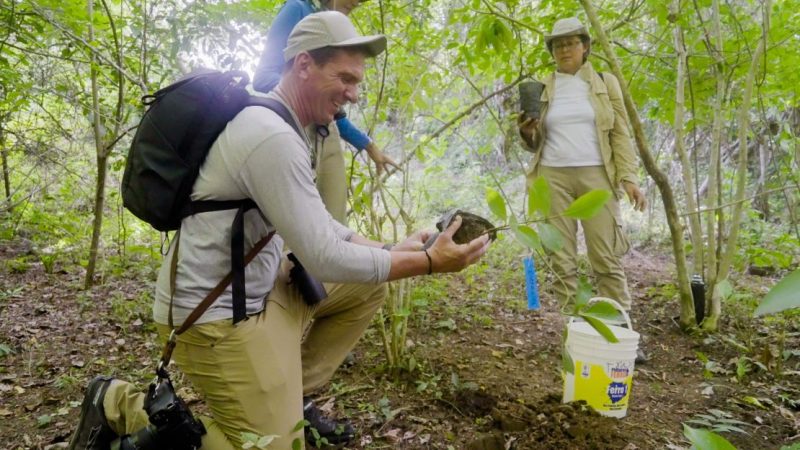To my son, born in the climate crisis: These helpers changed the fate of the titi


This is Bill Weir’s fourth letter on Earth Day to his young son. His new book, “Life As We Know it (Can Be),” is available now in stores.
Dear River,
This is your fourth Earth Day, and so much has happened in your little lifespan that what started as an annual record of anger and regret has grown into a book full of hopeful solutions.
There are still dark days to be sure, and since you love animals so much, I can’t bring myself to explain just how many of your favorites are on extinction’s brink.
But so much has happened that I wake with more wonder than worry; when disasters strike, I remember the advice of Mister Rogers, who taught me that every time there is a scary event on TV, “Look for the helpers. There are always helpers.”
And while technology in the hands of the soulless can divide us, it can also connect the helpers in ways that can save entire ecosystems.
So, on this Earth Day, kiddo, let’s focus on a win.
I recently stumbled upon an Earth repair success story in the wilds of South America. It stars a family of little monkeys with big white hair. They were snacking on fruit and nectar, bouncing through the forest overstory when we first locked eyes.
“You guys have no idea how lucky you are,” I muttered at the Dr. Suess faces peering through my long lens.
Cotton-top tamarins are known locally as titis, and while only a few thousand remain in the shrinking forests of northwest Colombia, the family I saw is among the safest in the world thanks to one woman watching them with affection from below, hundreds of helpers watching monitoring them through a satellite from above, and a very long series of fortunate events.
The fate of the titis really began to turn when a woman I met in the jungle began her career as landscape architect, was hired to help build a zoo in Barranquilla and first fell in love with the cotton-topped titi. “I mean, how could you not?” Rosamira Guillen laughed, gesturing up at the family above.
When she learned that the illegal pet trade and slash-and-burn cattle ranching were erasing a species that lived only in her homeland of Colombia, her architect mind suddenly shifted from building zoos to rebuilding forests.
And River, it didn’t take long to understand that this job could not be done by dropping seeds from drones. It would take shovels and sweat and an intimate acre-by-acre knowledge of the ecology. It would take community organizing and youth education and economic development so the titi’s human neighbors wouldn’t need to cut down trees and poach animals to survive.
But to connect enough fragmented habitat for the remaining gene pool to thrive, she would need land. And the cooperation of cattle ranchers who do not share her love for toy-sized primates.
“I would be happy to just hang out with the monkeys and in the forest than to have to interact with people,” she laughed as we bumped over dirt roads in her worn pickup, and described how wanton deforestation can change water cycles and trigger ecosystem crash.
“In a country like Colombia, where there’s so many challenges, people don’t realize that if you screw up the forest we’re all going to be screwed. The ranchers see us as romantic,” she laughed with grim resignation.
But still, Rosamira wanted to be a helper, and in a search for funding met an American super-helper named Charlie Knowles.
As the scion of a family that invented the small microphones used in everything from Apollo spacecraft to Richard Nixon’s office to the iPhone, Charlie went into software and made enough of a fortune to retire at 34. Inspired by the story of biologist Laurie Marker who sold all her possessions and moved to Namibia to save cheetahs, Charlie told me he felt the same calling but knew that he had none of the skills required.
“What are my core competencies?” he asked himself. “I’m really good at throwing parties and raising money.”
With a cheetah borrowed from a petting zoo as a conversation starter, his first party raised $5,000, and with kindred souls from Silicon Valley, he set out to disrupt the world of nature philanthropy. “I became really frustrated by the lack of transparency,” Charlie told me. “I didn’t feel I knew where my money was going or what the impact it was having.”
So – alongside Akiko Yamazaki, John Lukas – Charlie co-founded the Wildlife Conservation Network and instead of telling donors to simply write a check and trust the process, WCN set out to create venture capital for animals like the titi and helpers like Rosamira.
They created expos to connect philanthropists in wealthy American suburbs with data-proven, wilderness-restoring, boots-on-the-ground conservationists. And they helped those folks make their operations more efficient and effective and often expanded their original vision of what was possible.
More than 20 years later, Charlie tells me that WCN supports hundreds of projects around the world with raves from the likes of Jane Goodall and a rare perfect score of 100 from the watchdog Charity Navigator.
One million-dollar donation funded over 200 scholarships for kids to study conservation. Another donor personally installed over 50 solar power arrays around the world. And at an expo in 2006, the fate of the titis turned for the better when the Vargas family walked in.
“I told my 12-year-old daughter, Kira, to go interview all the conservationists at the expo,” Chris Vargas told me. As another successful tech entrepreneur with a heart for wildlife and some money to give, he was searching for maximum bang for his buck.
“And on the drive home. I said, ‘Who is your favorite?’ Mine was Rosamira. She’s Steve Jobs and Jane Goodall all wrapped into one. Her energy, her passion, her clarity of purpose and her just sheer ingenuity,” Chris said. “But I wanted my daughter’s vote, without missing a beat she goes, ‘Daddy, you know that that woman from Colombia? Rosamira? She was my favorite’. So we high fived.”
For 18 years, the Vargas family would support Rosamira as she revived her corner of Colombia, one tree at a time. But when she needed $1.2 million to buy nearly 1,000 acres of neighboring ranchland, Chris needed to find more helpers.
“We thought, ‘Why don’t we just build a website? And build a technology that lets anybody in the world click on a map, pick an acre, pick ten acres, pick 50 acres, and get all that feedback one exactly what happened with your money.’”
Combining the eyes of a satellite and the hearts of nature lovers, Chris began an experiment in crowdsourced conservation he called ReWorld.
For a one-time donation of around $1,200, he promised to secure two-and-a-half acres of degraded Colombian forest, bring it back to life and preserve it for the titis forever. Thanks to real-time images from the satellite, the donors would be able to watch their hectare grow from scrub brush and dirt into trees that look like broccoli tops from the sky.
I just got word that Rosamira signed the papers today.
“It may take a day to cut a hectare of forest,” she told me as we hiked past her plantings and into a meticulous greenhouse. “But to rebuild it, it takes about 20 years.”
What happens now? Well, Charlie and Chris are hoping the developed world will build trustworthy and verifiable carbon and biodiversity credit markets to help fund operations like Project Titi, though they both admit it will be incredibly complicated.
Still, River, when days get dark and I feel that need to look for the helpers, I sometimes flash to the series of fortunate events that gave almost 1,000 acres of forest to the titis — and I imagine all the spots that need similar love.
With enough helpers, what else is possible?











